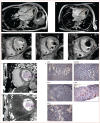Cardiac Involvement Due to COVID-19: Insights from Imaging and Histopathology
- PMID: 37942208
- PMCID: PMC10628999
- DOI: 10.15420/ecr.2023.02
Cardiac Involvement Due to COVID-19: Insights from Imaging and Histopathology
Abstract
Lingering cardiac symptoms are increasingly recognised complications of severe acute respiratory syndrome coronavirus 2 infection, now referred to as post-acute cardiovascular sequelae of COVID-19 (PASC). In the acute phase, cardiac injury is driven by cytokine release and stems from ischaemic and thrombotic complications, resulting in myocardial necrosis. Patients with pre-existing cardiac conditions are particularly vulnerable. Myocarditis due to a direct viral infection is rare. Chronic symptoms relate to either worsening of pre-existing heart disease (PASC - cardiovascular disease) or delayed chronic inflammatory condition due to heterogenous immune dysregulation (PASC - cardiovascular syndrome), the latter affecting a broad segment of previously well people. Both PASC presentations are associated with increased cardiovascular risk, long-term disability and reduced quality of life. The recognition and management of PASC in clinical settings remains a considerable challenge. Sensitive diagnostic methods are needed to detect subtler inflammatory changes that underlie the persistent symptoms in PASC - cardiovascular syndrome, alongside considerable clinical experience in inflammatory cardiac conditions.
Keywords: COVID-19; PASC; cardiovascular magnetic resonance; myocardial injury; myocarditis; post-acute sequelae of COVID-19.
Copyright © The Author(s), 2023. Published by Radcliffe Group Ltd.
Conflict of interest statement
Disclosure: VOP and EN have received speaker fees from Bayer and Siemens, and scientific grants from Bayer. All other authors have no conflicts of interest to declare.
Figures





References
-
- Writing Committee; Gluckman TJ, Bhave NM et al. 2022 ACC expert consensus decision pathway on cardiovascular sequelae of COVID-19 in adults: myocarditis and other myocardial involvement, post-acute sequelae of SARS-CoV-2 infection, and return to play: a report of the American College of Cardiology Solution Set Oversight Committee. J Am Coll Cardiol. 2022;79:1717–56. doi: 10.1016/j.jacc.2022.02.003. - DOI - PMC - PubMed
Publication types
LinkOut - more resources
Full Text Sources

